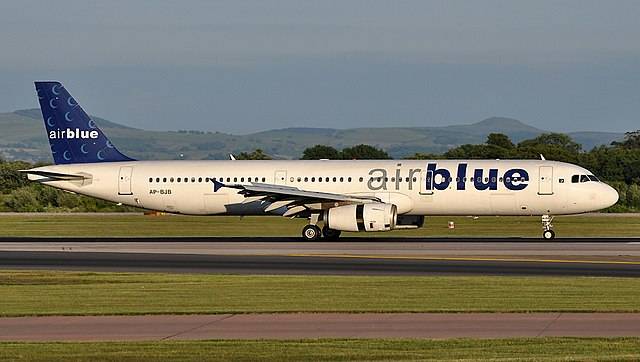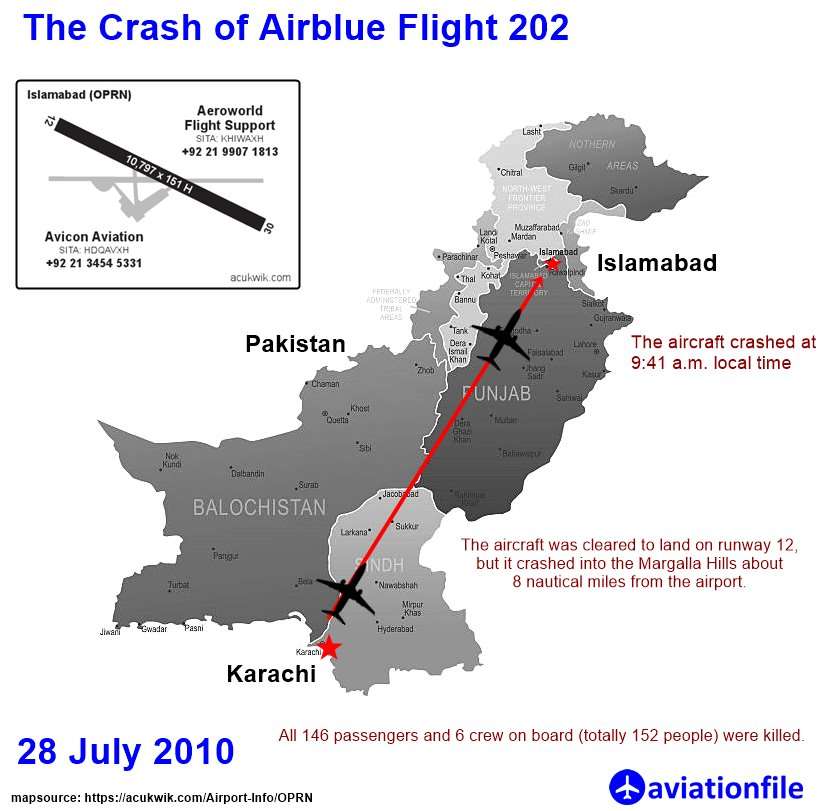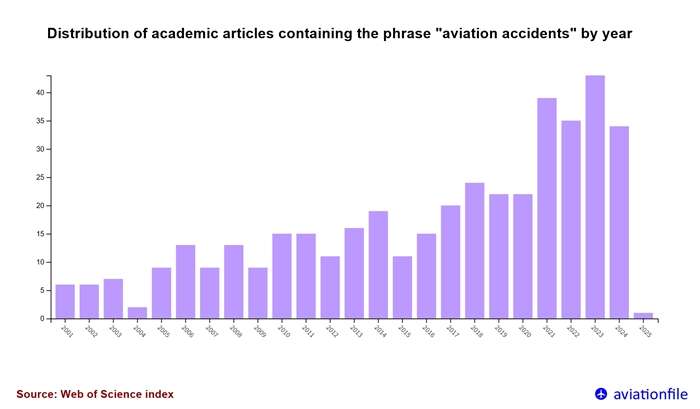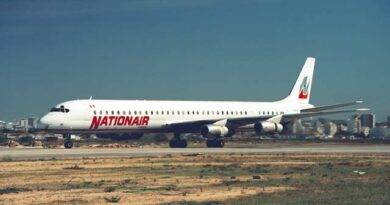The Crash of Airblue Flight 202: A Tragedy and Its Lessons
Airblue Flight 202 was an Airbus A321-231 jet airliner that crashed into the Margalla Hills, north of Islamabad’s Benazir Bhutto International Airport, on 28 July 2010, killing all 146 passengers and 6 crew on board (totally 152 people). It is the deadliest air accident to occur in Pakistan to date and the first fatal crash involving an Airbus A321.
The aircraft was en route from Karachi to Islamabad when it crashed at 9:41 a.m. local time. The weather conditions at the time were poor, with low visibility and heavy fog. The aircraft was cleared to land on runway 12, but it crashed into the hills about 8 nautical miles (15 kilometers) from the airport.

Investigators are still examining the cause of the crash, but they believe that the poor weather conditions may have disoriented the pilots. The aircraft was also flying below the minimum altitude for the approach, which may have contributed to the crash.
The crash of Airblue Flight 202 was a major tragedy that claimed the lives of 158 people. It is a reminder of the dangers of flying in poor weather conditions and the importance of following safety procedures.
Crew of Airblue Flight 202
Airblue Flight 202 was operated by Captain Pervez Iqbal Chaudry and First Officer Muntajib-ud-Din Ahmed. Captain Chaudry, aged 61, was a highly experienced pilot with over 25,000 flight hours. First Officer Ahmed, 34, was a former Pakistan Air Force fighter pilot with 1,837 total flight hours, including more than 280 hours on the Airbus A321 (Wikipedia) (Code7700).
The following are some of the factors that contributed to the crash of Airblue Flight 202:
- Poor weather conditions: The weather at the time of the crash was poor, with low visibility and heavy fog. This made it difficult for the pilots to see the ground and made it more likely that they would become disoriented.
- Low altitude: The aircraft was flying below the minimum altitude for the approach, which made it more difficult for the pilots to recover if they became disoriented.
- Pilot error: The pilots may have made some errors during the approach, such as not following the correct procedures or not taking into account the poor weather conditions.
- Technical problems: There is no evidence that the aircraft had any technical problems that contributed to the crash.
The crash of Airblue Flight 202 prompted changes in Pakistan’s air traffic control. Authorities raised the minimum altitude for approaches to Islamabad airport. They also implemented new procedures to prevent pilot disorientation in poor weather conditions.
The crash also led to a number of changes at Airblue. The airline implemented a new training program for pilots and improved its safety procedures.
In conclusion, the crash of Airblue Flight 202 serves as a sobering reminder of the critical importance of rigorous safety protocols in aviation. The tragedy spurred significant reforms in Pakistan’s air traffic control procedures, including higher minimum altitudes for airport approaches and improved measures to prevent pilot disorientation in adverse weather conditions. By learning from this incident, the aviation industry aims to enhance overall safety and prevent future accidents, ensuring that such a disaster does not happen again.

Scientific Articles Related with Aviation Accidents
Studies on aviation accidents were searched in the WoS (Web of Science) database in Topic section. Only articles were selected. As a result, 454 articles were reached. The bar chart below shows the distribution of these studies by year.

The image provided appears to represent data about aviation accidents, categorized by the number of incidents per year. Here is an analysis based on the visual representation:
- General Trend:
- The number of aviation accident publications fluctuates significantly over the years.
- There seems to be an overall upward trend with peaks and troughs.
- Notable Peaks:
- The year with the highest number of publications appears to be 2017, with a significant spike compared to surrounding years.
- Other high points include 2015 and 2024, indicating notable years for aviation incidents or studies.
- Low Points:
- The lowest bar corresponds to 2009, suggesting minimal publications or incidents reported that year.
- The years 2001, 2002, and 2008 also show relatively low activity.
- Steady Periods:
- The data from 2010 to 2014 appears relatively consistent without major spikes or declines, suggesting a stable phase in aviation reporting or accidents.
- Recent Years:
- After a dip around 2020, there seems to be a resurgence in publications by 2024, indicating either an increase in aviation accidents or renewed focus on reporting and studying them.
- Potential Reasons for Variations:
- Peaks could correlate with major aviation disasters, increased safety investigations, or regulatory changes.
- Dips might reflect periods of reduced aviation activity or less emphasis on publishing studies (e.g., during global crises like economic downturns or pandemics).
References:
- Airblue Flight 202 – Wikipedia: https://en.wikipedia.org/wiki/Airblue_Flight_202
- The Airblue Flight 202: Communication and Decision Making in Crisis: https://www.researchgate.net/publication/360019760_The_Airblue_Flight_202_Communication_and_Decision_Making_in_Crisis?_sg%5B0%5D=started_experiment_milestone
- How Toxic Leadership Sealed the Tragic Fate of Air Blue Flight 202: https://www.linkedin.com/pulse/how-toxic-leadership-sealed-tragic-fate-air-blue-202-
- image source: By Richard Vandervord – http://www.airliners.net/photo/Airblue/Airbus-A321-231/1740138/L/, CC BY-SA 4.0, https://commons.wikimedia.org/w/index.php?curid=11036309
- featured image source: https://www.npr.org/templates/story/story.php?storyId=128813003


